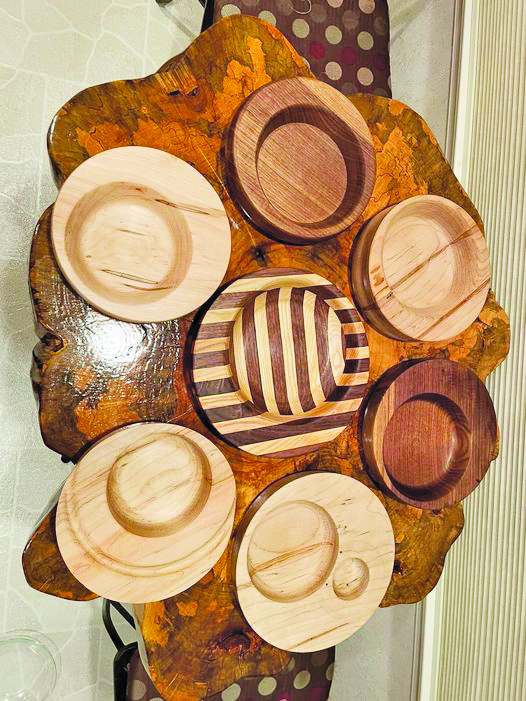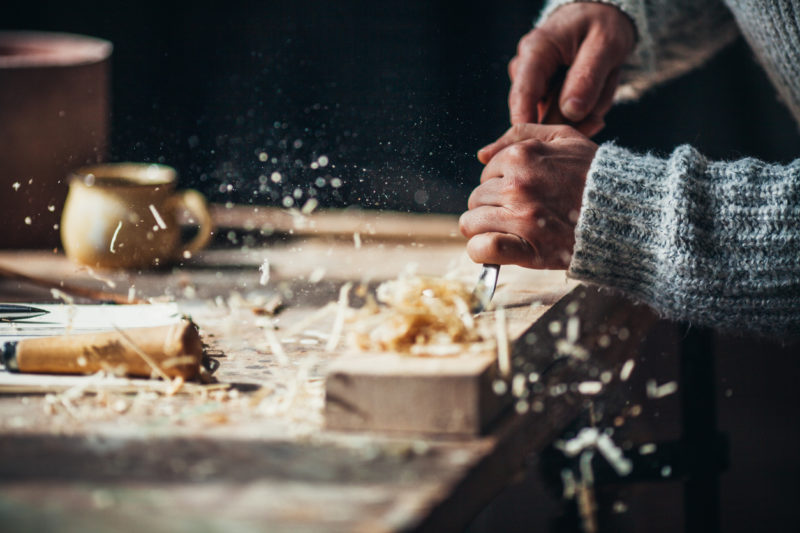Master woodworker creates marvels with his ‘magic’ hands
By Constance Garcia-Barrio
Bruce Driscoll, 72, of Roxborough, has created marvels with his hands all of his life. “My father was a do-it-yourselfer, and he had all kinds of tools,” said Driscoll. “I was allowed to use a lathe (wood-turning machine) early. I made my first project — probably a wooden toy — at age 8.”
More than six decades later, Driscoll is now a master woodworker who teaches at Philadelphia Woodworks, a wood shop offering instruction and custom fabrications, located at 4901 Umbria St., in Manayunk.
But there’s more to the story of Driscoll’s supple hands. In his teens, Driscoll conjured creations of another sort by becoming an amateur magician. “I used to perform at young kids’ birthday parties,” he said. In time, he stepped up his game. “After I moved to Philadelphia (from Ohio, where he was raised,) in 1972, I worked at night clubs, like Starr’s on Fourth Street and Grandma Minnie’s on Chestnut Street in Olde City. I’d do a couple of tricks between the time patrons got their drinks and the waiter brought their dinner.”
High demand kept Driscoll on the road six months out of the year, which meant little time at home with his wife. “I’d kept up woodworking in my leisure, so I switched things around,” he said. “I made woodworking my livelihood and magic my hobby.”
From then on, he’s devoted himself to his craft at establishments in New Jersey and Philadelphia. “One of my favorite pieces from that time is a copy of an 18th-century Chippendale lowboy,” he said, referring to a dressing table, created in the style of famed London cabinetmaker Thomas Chippendale.
Driscoll also made a huge breakfront out of genuine, seasoned mahogany, a scarce commodity. “The breakfront contains 500 pieces of wood and a satin finish,” he said. “It took eight weeks to make and cost thousands of dollars.”
While all his work is art in itself, he’s been commissioned to create pieces for Philadelphia museums. Driscoll has made vitrines (or display cases) for the Rosenbach Museum, which houses rare books and manuscripts in two townhouses located on the 2000 block of Delancey Place.
Visitors to Independence Seaport Museum can see Driscoll’s work there, too. “I built the case for the diorama of old Philadelphia,” he said. “I made cradles (where display boats rest), as well. It was a challenge using water-based finishes on the wood since they take longer to dry and tend to melt into previous coats. They’re needed because solvent-based finishes give off gases that damage the museum artifacts. By the same token, you can’t use certain woods in museums, either. For example, red oak releases tannic acid, which could affect some items.”
After a fulfilling woodworking career, Driscoll retired in 2017. “With all I had learned, I wanted to give something back to the art,” he said. “Now, I teach (woodworking skills to) people of all ages, including many retirees. Artistic expression seems to become more important as we age. Some older people are going from something white-collar, where you have a spreadsheet full of numbers to show for your work, to, say, making a saltcellar (a small container for storing salt). A psychologist who just retired from the Philadelphia School District now spends four hours a day here, turning out small wooden bowls.”
Driscoll’s students are usually eager to handle the fragrant wood, but he spends time talking about intangibles first. “I explain that woodworking requires patience,” he said. “That’s the hardest part of teaching. I had no real disasters during my career because I did research first. You draw what you want to make. You do 17 revisions, so you have a good idea of what you want in your head and on paper.”
Driscoll also stresses that wood has a life of its own. “When I teach a class, I spend half the time talking about the movement of wood. It expands and contracts with the seasons,” he said. “You have to take that into account. If not, the piece of furniture develops cracks or gets pushed up in the center.”
Woodworking can be deeply relaxing, Driscoll notes. “No matter what your background, if you can handle the tools, you get respect,” he said. “And it’s satisfying to have whatever you have built sitting in front of you. There’s pride in being able to say, ‘I built this with my own two hands.’”
For more information or a tour of Philadelphia Woodworks, call 267-331-5880 or go to PhiladelphiaWoodworks.com.
An accidental woodworker

Five years ago, Mathew Meltzer, 68, of Wyndmoor, took an unexpected turn onto Umbria Street one day while coming home from lunch with friends. “I saw the Philadelphia Woodworks sign and stopped in for a tour,” he recalls.
Meltzer soon became a regular woodworker. “I never knew I had an artistic side until I began woodworking,” said the retired financial advisor. “You take a chunk of wood, turn it on the lathe and create something. I make bowls, sometimes ornamental, sometimes functional. I also make boxes, about five or six square inches, that I call ‘memory boxes’ to hold small mementos for family and friends. You can put lots of design enhancements on the box.”
He likes working with walnut and cherry, but bocote, a wood from Mexico, Central America and the West Indies, is his favorite material. “It’s a hard, heavy, dense, wood,” Meltzer said. “You can’t tell what grain pattern you’ll discover until you open up the wood. I like the surprise.”
Meltzer also values the workshop’s camaraderie. “There are all kinds of people here, including lots of women and older adults. It’s like a social club with sawdust.”
Native Philadelphian Constance Garcia-Barrio writes about many topics, including Black history.




